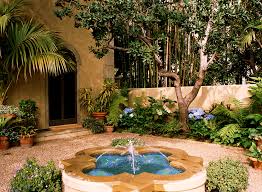
The elements of a garden are diverse including, but not limited to, hardscaping, softscaping, irrigation, drainage, lights, water features and steps. We explore how each element impacts on the overall look you wish to achieve in your green space.
Lighting
Garden lighting allows you to make the most of your garden, day and night. It works well when a selected few areas are lit to highlight attractive features.
For safety reasons it is important that pathways and entrances are visible at night time. You may even like to have a sensor light installed to alert you of guests or intruders.
Lighting can also provide atmosphere for night time entertaining outdoors. Fairy lights, lanterns, up lights and down lights that are correctly placed can bring your garden to life at night. You will also need to have sufficient lighting around the outdoor cooking and dining areas.
Read more: Jamie Durie: tips for outdoor rooms
Water features
Ponds and water features are always popular. They require a power supply and for maximum effect, you should place them where you can hear and see them. There are many different forms of water features. Rocks, pots, and walls can all be used; you are only limited by your imagination.
Steps
Steps can be both a useful tool for transportation and a design feature. A garden stair can be made of a range of materials, with stone, wood and pavers the most popular choices but do not be afraid to get creative.
Determine where the steps will lead, how many you will need and the gradient of the climb. You should also calculate the depth and the height of each step and make sure that these measurements are uniform. Your local council or builder may have guidelines and offer you advice on these dimensions.
If you are looking to make your steps a feature of the garden engage the services of a landscape architect to help you achieve the vision for your overall desgin.
Outdoor features
These can add individuality and character to your garden. Depending on the look you are trying to create, bird baths, pots, sundials, pagodas, lanterns and stones can all contribute to your preferred style of garden. Anything goes and there are no formal rules, but generally less is more.
Drainage
A common problem with newly planted trees is they receive too much or too little water. This can be due to poorly draining soil. Areas with standing water or signs of algae are a sure sign that you have drainage problems. A properly thought out drainage system will carry water away from the roots.
Irrigation
There are a number of different irrigation systems to choose from to ensure that your garden is kept well watered.
Drip systems are effective and can be installed below the surface, releasing water directly to the root systems of the plants with no evaporation loss.
Above ground sprinkling systems ensure the areas that need to be watered are actually receiving the water. A variety of sprinkler heads can be installed. Many have adjustable flow rates.
A great way to save water and effort is to install a timed irrigation system. If there has been a lot of rain, remember to turn your system off.
Read more: How to: create a hanging garden
Kerbs and edging
Edging and kerbing are a great way to separate areas of your garden visually as well as physically; and keep people on pathways. Different materials can be used to create different looks. Wood, concrete, stone, clay tiles, pavers, steel and plastics can all work well as edging or kerbing. When choosing materials look at the style of your garden, where you plan to use the edging or kerbing and whether extra maintenance will be necessary to prevent it becoming overgrown by lawn.
Decorative concrete
An effective way to improve the look of a concreted area is to have a stain, stencil or stamped pattern applied to the surface of the concrete. There are a vast array of colour patterns and styles to suit all types of gardens and areas. These applications work well on paths, driveways, stairs and patios; in fact almost any concreted surface. Most finishes will, however, have to be applied at the time the concrete is poured.